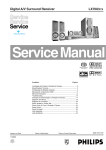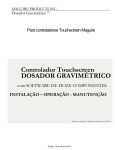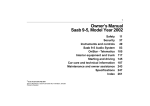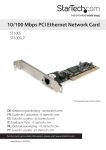Download IB530F/IB530 Series USER`S MANUAL
Transcript
IB530F/IB530 Series AMD Geode LX 3.5-inch Disk Size SBC USER’S MANUAL Version 1.0 Acknowledgments Award is a registered trademark of Award Software International, Inc. PS/2 is a trademark of International Business Machines Corporation. AMD, AMD Geode, and combinations thereof, are trademarks of Advanced Micro Devices, Inc. Microsoft Windows is a registered trademark of Microsoft Corporation. All other product names or trademarks are properties of their respective owners. ii IB530F User’s Manual Table of Contents Introduction ....................................................... 1 Product Description ............................................................. 1 Checklist .............................................................................. 2 Specifications ...................................................................... 3 Board Dimensions ............................................................... 4 Installations ....................................................... 5 Installing the Memory ......................................................... 6 Setting the Jumpers ............................................................. 7 Connectors on IB530F ...................................................... 10 BIOS Setup ....................................................... 19 Drivers Installation ...................................... 35 Entertainment Encryption/Decryption Controller Driver.. 36 VGA Drivers Installation .................................................. 38 Audio Driver Installation .................................................. 41 PCI Bridge Driver Installation .......................................... 44 Appendix ........................................................... 47 A. I/O Port Address Map................................................... 47 B. Interrupt Request Lines (IRQ) ...................................... 48 C. Watchdog Timer Configuration.................................... 49 IB530F User’s Manual iii This page is intentionally left blank. iv IB530F User’s Manual INTRODUCTION Introduction Product Description The IB530F 3.5-inch disk size SBC incorporates the AMD Geode LX processor with speeds of 433MHz (LX700), 500MHz (LX800) or 600MHz (LX900). It comes with one DDR SO-DIMM socket that has a capacity of 1GB system memory. The board supports two 10/100Mbps Ethernet, using Realtek RTL8100C controllers. A 2D graphics controller comes integrated on the board that supports CRT and TFT LCD displays. Useful interface includes four USB 2.0 ports, 4 COM ports, and one PC-104 expansion slot (Non-DMA ISA ONLY, PCI not supported). Other expansion options are available with the Compact Flash socket. IB530F FEATURES: - Embedded AMD Geode LX processor, 433MHz (LX700) / 500MHz (LX800), 600MHz (LX900). - DDR SO-DIMM x 1, Max. 1GB - Realtek RTL8100C 10/100Mbps Ethernet x2 - Integrated LX800/LX700 2D VGA controller, supports CRT and TFT LCD display - 4 x USB 2.0, 4 x COM, CF socket, Watchdog timer, Digital I/O - PC-104 expansion (Non-DMA ISA only, PCI not supported) - Dimensions: 145mm x 102mm (5.7” x 4”) IB530F User’s Manual 1 INTRODUCTION Checklist Your IB530F package should include the items listed below. • The IB530F AMD Geode LX 3.5-inch Disk Size SBC • This User’s Manual • 1 CD containing chipset drivers and flash memory utility • Heatsink for AMD Geode LX processor • Options: • cable kit (IDE, COM, PS/2, LPT, USB, Audio, Power cable) 2 IB530F User’s Manual INTRODUCTION Specifications [ CPU CPU Internal Speed Power Management BIOS Chipset Memory Graphic LVDS Ethernet IDE Audio USB LPC I/O Secondary I/O PCI Arbiter RTC Edge Connectors Onboard Headers Expansion Slot Digital I/O Power Watchdog Timer RoHS Compliant Board Size AMD Geode LX CPU, 481-ball BGA LX800 @500MHz LX700 @433MHz LX900@600MHz APM Award BIOS AMD CS5536 I/O companion multi-function south bridge One DDR SO-DIMM socket, Max. up to 1GB LX900/LX800/LX700 built-in high performance 2D graphic controller, supports TFT, LVDS LCD & CRT display 18-bit single channel LVDS 2x Realtek RTL8100C-LF 10/100Mbps Ethernet chip CS5536 built-in one channel UDMA100 IDE - 44-pin header x1 - Compact Flash (type II) connector x1 Realtek ALC203 AC97 audio codec, supports 2-CH Line-Out, Line-In & MIC CS5536 built-in USB2.0 controller, support 4 ports Winbond W83627HF: KB/Mouse controller, Parallel, IrDA, Floppy, COM1, COM2 (RS232) & Hardware monitor (3 thermal inputs, 4 voltage monitor inputs, VID0-4 & 2 Fan Headers) Fintek 81216 for COM3/COM4 IT8209R PCI arbiter/clock buffer, extend PCI devices (master) from 1 to 3 CS5536 built-in, with on board Lithium battery DB-9 connector x1 for COM1 (RS232 only) DB-15 connector x1 for CRT RJ-45 connector x2 for LAN 6-pin header x1 for PS/2 KB/Mouse (Y cable) DF13-20 header x1 for LVDS channel Compact Flash Socket x1 for CF card 10-pin header x1 for COM1 (RS232 only) 30-pin header x1 for COM2/3/4 8-pin header for USB0, 1 8-pin header x1 for USB2, 3 26-pin header x1 for LPT port 44-pin header x1 for IDE 26-pin header x1 for FDD 12-pin header x1 for Audio 4-pin header x1 for IrDA 10-pin header x1 for Digital I/O 44-pin header x1 for TFT LCD panel PC-104 w/ 4 mounting holes(Non DMA ISA ONLY,Not support PCI) Supports 4 In / 4 Out +12V DC-in Software programmable, supports 1~255 sec. system reset Yes 145 x 102mm IB530F User’s Manual 3 INTRODUCTION Board Dimensions 4 IB530F User’s Manual INSTALLATIONS Installations This section provides information on how to use the jumpers and connectors on the IB530F in order to set up a workable system. The topics covered are: Installing the Memory .................................................................. 6 Setting the Jumpers ...................................................................... 7 Connectors on IB530F ............................................................... 10 IB530F User’s Manual 5 INSTALLATIONS Installing the Memory The IB530F board supports one SODIMM DDR memory socket for a maximum total memory. The memory module capacities supported are 128MB, 256MB, 512MB and 1GB. Installing and Removing Memory Modules To install the DDR modules, locate the memory slot on the board and perform the following steps: 1. Hold the DDR module so that the keys of the DDR module align with those on the memory slot. Insert the module into the socket at a slight angle (approximately 30 degrees). Note that the socket and module are both keyed, which means that the module can be installed only in one direction. 2. To seat the memory module into the socket, apply firm and even pressure to each end of the module until you feel it slip down into the socket. 3. With the module properly seated in the socket, rotate the module downward. Continue pressing downward until the clips at each end lock into position. 4. To remove the DDR module, press the clips with both hands. 6 IB530F User’s Manual INSTALLATIONS Setting the Jumpers Jumpers are used on IB530F to select various settings and features according to your needs and applications. Contact your supplier if you have doubts about the best configuration for your needs. The following lists the connectors on IB530F and their respective functions. Jumper Locations on IB530F ......................................................... 8 JP1: Clear CMOS Setting ............................................................... 9 JP2: LVDS VDD Select (5V / 3.3V) .............................................. 9 JP3: HDD LED Pin Header ............................................................ 9 JP4: CF Connector master/Slave Setting ........................................ 9 JP5, JP6: COM3,4 RS232 +5V/+12V Power Setting..................... 9 IB530F User’s Manual 7 INSTALLATIONS Jumper Locations on IB530F Jumpers on IB530F ............................................................................... Page Jumper Locations on IB530F ...................................................................... 8 JP1: Clear CMOS Setting ........................................................................... 9 JP2: LVDS VDD Select (5V / 3.3V) .......................................................... 9 JP3: HDD LED Pin Header ........................................................................ 9 JP4: CF Connector master/Slave Setting .................................................... 9 JP5, JP6: COM3,4 RS232 +5V/+12V Power Setting ................................. 9 8 IB530F User’s Manual INSTALLATIONS JP1: Clear CMOS Setting Use JP1 to clear the CMOS contents. Note that the power connector should be disconnected from the board before clearing CMOS. JP1 Function Normal (default) Clear CMOS JP2: LVDS VDD Select (5V / 3.3V) JP2 VDD Setting 3.3V 5V JP3: HDD LED Pin Header Pin # Signal Name 1 VCC 2 HDD_LEDJP4: CF Connector master/Slave Setting JP4 Setting Function Short/Closed Master Open Slave JP5, JP6: COM3,4 RS232 +5V/+12V Power Setting JP5, JP6 Setting Pin 1-2 Short/Closed Pin 3-4 Short/Closed Pin 5-6 Short/Closed IB530F User’s Manual Function +12V Normal +5V 9 INSTALLATIONS Connectors on IB530F The connectors on IB530F allows you to connect external devices such as keyboard, floppy disk drives, hard disk drives, printers, etc. The following table lists the connectors on IB530F and their respective functions. Connector Locations on IB530F ................................................... 11 CN1, CN2: RJ45 Connector ......................................................... 12 CN3: VGA CRT Connector.......................................................... 12 CN4: Compact Flash Card Socket ................................................ 12 CN5: FDD Connector ................................................................... 12 CN6, J13: Serial port .................................................................... 13 CN6 is the D-sub type COM1 serial port connector ..................... 13 CN7: PC-104 Connector ............................................................... 14 J2: Reset Switch ............................................................................ 15 J4: External Audio Connector ...................................................... 15 J5: TFT Panel Connector .............................................................. 15 J6: LVDS Connectors ................................................................... 16 J7: IrDA Connector ...................................................................... 16 J9, J15: USB Connectors .............................................................. 16 J10: PS/2 Keyboard and Mouse Connector .................................. 16 J11: Parallel Port Connector ......................................................... 17 J14: Power DC-In ......................................................................... 17 J16: Digital 4-in 4-out Connector ................................................. 17 IDE1: IDE Connector ................................................................... 18 SODIMM1: SO DIMM Socket .................................................... 18 10 IB530F User’s Manual INSTALLATIONS Connector Locations on IB530F Connectors on IB530F............................................................... Page CN1, CN2: RJ45 Connector...................................................................................... 12 CN3: VGA CRT Connector ...................................................................................... 12 CN4: Compact Flash Card Socket ............................................................................ 12 CN5: FDD Connector ............................................................................................... 12 CN6, J13: Serial Ports ............................................................................................... 13 CN7: PC-104 Connector (Non DMA ISA ONLY,Not Support PCI) ...................... 14 J2: Reset Switch ........................................................................................................ 15 J4: External Audio Connector ................................................................................... 15 J5: TFT Panel Connector .......................................................................................... 15 J6: LVDS Connectors ............................................................................................... 16 J7: IrDA Connector ................................................................................................... 16 J9, J15: USB Connectors .......................................................................................... 16 J10: PS/2 Keyboard and Mouse Connector .............................................................. 16 J11: Parallel Port Connector ..................................................................................... 17 J14: Power DC-In ...................................................................................................... 17 J16: Digital 4-in 4-out Connector ............................................................................. 17 IDE1: IDE Connector ................................................................................................ 18 SODIMM1: SO DIMM Socket ................................................................................. 18 IB530F User’s Manual 11 INSTALLATIONS CN1, CN2: RJ45 Connector Pin # 1 2 3 4 5 6 7 8 CN3: VGA CRT Connector Signal Name Red Blue GND GND Vcc N.C. HSYNC DDCCLK Signal Name TD+ TDRD+ RJ45-4A RJ45-5A RDRJ45-7A RJ45-8A [ Pin 1 3 5 7 9 11 13 15 Pin 2 4 6 8 10 12 14 Signal Name Green NC GND GND GND DDCDA VSYNC CN4: Compact Flash Card Socket CN5: FDD Connector Signal Name VCC VCC VCC NC NC DINST NC GND GND GND NC GND GND 12 Pin # Pin # Signal Name 1 3 5 7 9 11 13 15 17 19 21 23 25 2 4 6 8 10 12 14 16 18 20 22 24 26 INDEX DRV_SEL DSK_CH NC MOTOR DIR STEP WDATA WGATE TRACK WPROT RDATA SIDE IB530F User’s Manual INSTALLATIONS CN6, J13: Serial port CN6 is the D-sub type COM1 serial port connector Pin # Signal Name (RS-232) 1 2 3 4 5 6 7 8 9 DCD, Data carrier detect RXD, Receive data TXD, Transmit data DTR, Data terminal ready Ground DSR, Data set ready RTS, Request to send CTS, Clear to send RI, Ring indicator J13 (COM2/3/4) is a 30-pin header type COM2/3/4 serial port (RS232) connector. Signal Name DCD2 SIN2 SO2 DTR2GND DCD3 SIN3 SOUT3 DTR3 GND DCD4 SIN4 SOUT4 DTR4 GND Pin # 1 3 5 7 9 11 13 15 17 19 21 23 25 27 29 Pin # 2 4 6 8 10 12 14 16 18 20 22 24 26 28 30 IB530F User’s Manual Signal Name DSR2 RTS2 CTS2 RI2 N/A DSR3 RTS3 CTS3 RI3N/A DSR4 RTS4 CTS4 RI4 Protect pin 13 INSTALLATIONS CN7: PC-104 Connector The PC-104 connector* is a dual-in-line pin headers that support PC-104 ISA modules, with 64 pins and 40 pins in each line. The following table shows the their pin assignments. *(Non-DMA ISA ONLY) Pin A1 A2 A3 A4 A5 A6 A7 A8 A9 A10 A11 A12 A13 A14 ZA15 A16 A17 A18 A19 A20 A21 A22 A23 A24 A25 A26 A27 A28 A29 A30 A31 A32 14 CON1 Signal Name Pin IOCHK B1 D7 B2 D6 B3 D5 B4 D4 B5 D3 B6 D2 B7 D1 B8 D0 B9 IOCHRDY B10 AEN B11 A19 B12 A18 B13 A17 B14 A16 B15 A15 B16 A14 B17 A13 B18 A12 B19 A11 B20 A10 B21 A9 B22 A8 B23 A7 B24 A6 B25 A5 B26 A4 B27 A3 B28 A2 B29 A1 B30 A0 B31 GND B32 Signal Name GND REST VCC IRQ9 -5V DRQ2 -12V OWS +12V Key SMEMW SMEMR IOW IOR DACK3 DRQ3 DACK1 DRQ1 REFRESH CLK IRQ7 IRQ6 IRQ5 IRQ4 IRQ3 DACK2 TC BALE VCC OSC GND GND Pin C1 C2 C3 C4 C5 C6 C7 C8 C9 C10 C11 C12 C13 C14 C15 C16 C17 C18 C19 C20 CON2 Signal Name Pin GND D1 SBHE D2 LA23 D3 LA22 D4 LA21 D5 LA20 D6 LA19 D7 LA18 D8 LA17 D9 MEMR D10 MEMW D11 D8 D12 D9 D13 D10 D14 D11 D15 D12 D16 D13 D17 D14 D18 D15 D19 KEY PIN D20 IB530F User’s Manual Signal Name GND MEMCS16 IOCS16 IRQ10 IRQ11 IRQ12 IRQ15 IRQ14 DACK0 DRQ0 DACK5 DRQ5 DACK6 DRQ6 DACK7 DRQ7 VCC MASTER GND GND INSTALLATIONS J2: Reset Switch Pin # 1 2 Signal Name Reset Ground J4: External Audio Connector J4 is a 12-pin header that is used to connect to the optional audio cable card that integrates jacks for Line In, Line Out and Mic. Signal Name Signal Name Pin # Pin # LINEOUT R 1 2 LINEOUT L Ground 3 4 Ground LINEIN R 5 6 LINEIN L Ground 7 8 Ground Mic-In 9 10 VREFOUT Ground 11 12 Protect pin J5: TFT Panel Connector J5 is the pin header for TFT flat panel LCD displays. Signal Name +12V Ground 5V/3.3V N.C. R0 R2 R4 R6 G0 G2 G4 G6 B0 B2 B4 B6 Ground SHFCLK DISPENA(MDE) Ground Ground ENAVDD Pin # 1 3 5 7 9 11 13 15 17 19 21 23 25 27 29 31 33 35 37 39 41 43 Pin # 2 4 6 8 10 12 14 16 18 20 22 24 26 28 30 32 34 36 38 40 42 44 Signal Name +12V Ground 5V/3.3V Ground R1 R3 R5 R7 G1 G3 G5 G7 B1 B3 B5 B7 Ground FLM(VSYNC) LP(HSYNC) ENABKL N.C. 5V/3.3V *Depends on JP2 setting (1-2 for 3.3V/default, 2-3 for 5V). IB530F User’s Manual 15 INSTALLATIONS J6: LVDS Connectors Signal Name TX0Ground TX15V/3.3V TX3TX2Ground TXC5V/3.3V +12V Pin # 2 4 6 8 10 12 14 16 18 20 Pin # 1 3 5 7 9 11 13 15 17 19 Signal Name TX0+ Ground TX1+ Ground TX3+ TX2+ Ground TXC+ ENABKL +12V *Depends on JP2 setting (1-2 for 3.3V/default, 2-3 for 5V). J7: IrDA Connector J7 is used for an optional IrDA connector for wireless communication. Pin # Signal Name 1 +5V 2 Ir RX 3 Ground 4 Ir TX J9, J15: USB Connectors The J9, J15 USB pin header connectors support Four USB 2.0 ports via optional USB cables. Signal Name +5V USB0USB0+ Ground Pin 1 2 3 4 Pin 5 6 7 8 Signal Name Ground USB1+ USB1+5V J10: PS/2 Keyboard and Mouse Connector J10 is a 6-pin header for the external keyboard connector Pin # 1 2 3 4 5 6 16 Signal Name Keyboard Data Keyboard Clock Mouse Data Mouse Clock Ground Vcc IB530F User’s Manual INSTALLATIONS J11: Parallel Port Connector Signal Name Line printer strobe PD0, parallel data 0 PD1, parallel data 1 PD2, parallel data 2 PD3, parallel data 3 PD4, parallel data 4 PD5, parallel data 5 PD6, parallel data 6 PD7, parallel data 7 ACK, acknowledge Busy Paper empty Select Pin # 1 2 3 4 5 6 7 8 9 10 11 12 13 Pin # 14 15 16 17 18 19 20 21 22 23 24 25 N/A Signal Name AutoFeed Error Initialize Select Ground Ground Ground Ground Ground Ground Ground Ground Protect pin J14: Power DC-In Pin # 1 2 Signal Name DC In (12V only) Ground J16: Digital 4-in 4-out Connector Signal Name Ground Out3 Out2 IN3 IN2 Pin 1 3 5 7 9 Pin 2 4 6 8 10 IB530F User’s Manual Signal Name Vcc Out1 Out0 IN1 IN0 17 INSTALLATIONS IDE1: IDE Connector Signal Name Pin # Pin # Signal Name Reset IDE Host data 7 Host data 6 Host data 5 Host data 4 Host data 3 Host data 2 Host data 1 Host data 0 Ground DRQ0 Host IOW Host IOR IOCHRDY DACK0 IRQ14 Address 1 Address 0 Chip select 0 Activity Vcc Ground 1 3 5 7 9 11 13 15 17 19 21 23 25 27 29 31 33 35 37 39 41 43 2 4 6 8 10 12 14 16 18 20 22 24 26 28 30 32 34 36 38 40 42 44 Ground Host data 8 Host data 9 Host data 10 Host data 11 Host data 12 Host data 13 Host data 14 Host data 15 Key Ground Ground Ground Host ALE Ground No connect No connect Address 2 Chip select 1 Ground Vcc N.C. SODIMM1: SO DIMM Socket 18 IB530F User’s Manual BIOS SETUP BIOS Setup This chapter describes the different settings available in the Award BIOS that comes with the board. The topics covered in this chapter are as follows: BIOS Introduction ........................................................................ 20 BIOS Setup ................................................................................... 20 Standard CMOS Setup ................................................................. 22 Advanced BIOS Features ............................................................. 25 Advanced Chipset Features .......................................................... 28 Integrated Peripherals ................................................................... 29 Power Management Setup ............................................................ 31 PNP/PCI Configurations .............................................................. 32 PC Health Status ........................................................................... 33 Load Fail-Safe Defaults................................................................ 34 Load Optimized Defaults ............................................................. 34 Set Password ................................................................................ 34 Save & Exit Setup ........................................................................ 34 Exit Without Saving ..................................................................... 34 IB530F User’s Manual 19 BIOS SETUP BIOS Introduction The Award BIOS (Basic Input/Output System) installed in your computer system’s ROM supports various processors. The BIOS provides critical low-level support for a standard device such as disk drives, serial ports and parallel ports. It also adds virus and password protection as well as special support for detailed fine-tuning of the chipset controlling the entire system. BIOS Setup The Award BIOS provides a Setup utility program for specifying the system configurations and settings. The BIOS ROM of the system stores the Setup utility. When you turn on the computer, the Award BIOS is immediately activated. Pressing the <Del> key immediately allows you to enter the Setup utility. If you are a little bit late pressing the <Del> key, POST (Power On Self Test) will continue with its test routines, thus preventing you from invoking the Setup. If you still wish to enter Setup, restart the system by pressing the ”Reset” button or simultaneously pressing the <Ctrl>, <Alt> and <Delete> keys. You can also restart by turning the system Off and back On again. The following message will appear on the screen: Press <DEL> to Enter Setup In general, you press the arrow keys to highlight items, <Enter> to select, the <PgUp> and <PgDn> keys to change entries, <F1> for help and <Esc> to quit. When you enter the Setup utility, the Main Menu screen will appear on the screen. The Main Menu allows you to select from various setup functions and exit choices. 20 IB530F User’s Manual BIOS SETUP Phoenix - AwardBIOS CMOS Setup Utility Standard CMOS Features Advanced BIOS Features Advanced Chipset Features Integrated Peripherals Power Management Setup PnP/PCI Configurations PC Health Status Load Fail-Safe Defaults Load Optimized Defaults Set Supervisor Set User Password Save & Exit Setup Exit Without Saving ESC : Quit F10 : Save & Exit Setup Ç È Æ Å : Select Item Time, Date, Hard Disk Type… The section below the setup items of the Main Menu displays the control keys for this menu. At the bottom of the Main Menu just below the control keys section, there is another section, which displays information on the currently highlighted item in the list. Note: If the system cannot boot after making and saving system changes with Setup, the Award BIOS supports an override to the CMOS settings that resets your system to its default. Warning: It is strongly recommended that you avoid making any changes to the chipset defaults. These defaults have been carefully chosen by both Award and your system manufacturer to provide the absolute maximum performance and reliability. Changing the defaults could cause the system to become unstable and crash in some cases. IB530F User’s Manual 21 BIOS SETUP Standard CMOS Setup “Standard CMOS Setup” choice allows you to record some basic hardware configurations in your computer system and set the system clock and error handling. If the motherboard is already installed in a working system, you will not need to select this option. You will need to run the Standard CMOS option, however, if you change your system hardware configurations, the onboard battery fails, or the configuration stored in the CMOS memory was lost or damaged. Phoenix - AwardBIOS CMOS Setup Utility Standard CMOS Features Date (mm:dd:yy) Fri, Jun 30, 2006 Time (hh:mm:ss) 00 : 00 : 00 Menu Level > Item Help IDE Primary Master IDE Primary Slave None None Change the day, month, Year and century Drive A Drive B 1.44” None Video Halt On EGA/VGA All, But keyboard Base Memory Extended Memory Total Memory 640K 514816K 515584K At the bottom of the menu are the control keys for use on this menu. If you need any help in each item field, you can press the <F1> key. It will display the relevant information to help you. The memory display at the lower right-hand side of the menu is read-only. It will adjust automatically according to the memory changed. The following describes each item of this menu. Date The date format is: Day : Month : Date : Year : Sun to Sat 1 to 12 1 to 31 1999 to 2099 To set the date, highlight the “Date” field and use the PageUp/ PageDown or +/- keys to set the current time. 22 IB530F User’s Manual BIOS SETUP Time The time format is: Hour : 00 to 23 Minute : 00 to 59 Second : 00 to 59 To set the time, highlight the “Time” field and use the <PgUp>/ <PgDn> or +/- keys to set the current time. IDE Primary HDDs / IDE Secondary HDDs The onboard PCI IDE connectors provide Primary and Secondary channels for connecting up to four IDE hard disks or other IDE devices. Each channel can support up to two hard disks; the first is the “Master” and the second is the “Slave”. Press <Enter> to configure the hard disk. The selections include Auto, Manual, and None. Select ‘Manual’ to define the drive information manually. You will be asked to enter the following items. CYLS : HEAD : PRECOMP : LANDING ZONE : SECTOR : Number of cylinders Number of read/write heads Write precompensation Landing zone Number of sectors The Access Mode selections are as follows: CHS (HD < 528MB) LBA (HD > 528MB and supports Logical Block Addressing) Large (for MS-DOS only) Auto Remarks: The main board supports two serial ATA ports and are represented in this setting as IDE Channel 2 / 3 Master. Drive A / Drive B These fields identify the types of floppy disk drive A or drive B that has been installed in the computer. The available specifications are: 360KB 1.2MB 720KB 1.44MB 2.88MB 5.25 in. 5.25 in. 3.5 in. 3.5 in. 3.5 in. IB530F User’s Manual 23 BIOS SETUP Video This field selects the type of video display card installed in your system. You can choose the following video display cards: EGA/VGA For EGA, VGA, SEGA, SVGA or PGA monitor adapters. (default) CGA 40 Power up in 40 column mode. CGA 80 Power up in 80 column mode. MONO For Hercules or MDA adapters. Halt On This field determines whether or not the system will halt if an error is detected during power up. No errors The system boot will not be halted for any error that may be detected. All errors Whenever the BIOS detects a non-fatal error, the system will stop and you will be prompted. All, But Keyboard The system boot will not be halted for a keyboard error; it will stop for all other errors All, But Diskette The system boot will not be halted for a disk error; it will stop for all other errors. All, But Disk/Key The system boot will not be halted for a keyboard or disk error; it will stop for all others. 24 IB530F User’s Manual BIOS SETUP Advanced BIOS Features This section allows you to configure and improve your system and allows you to set up some system features according to your preference. Phoenix - AwardBIOS CMOS Setup Utility Advanced BIOS Features Virus Warning CPU Internal Cache First Boot Device Second Boot Device Third Boot Device Boot Other Device Swap Floppy Drive Boot Up Floppy Seek Boot Up NumLock Status Gate A20 Option Typematic Rate Setting Typematic Rate (Chars/Sec) Typematic Delay (Msec) Security Option OS Select For DRAM>64MB Small Logo (EPA) Show Disabled Enabled Floppy HDD-0 CDROM Enabled Disabled Disabled On Fast Disabled 6 250 Setup Non-OS2 Disabled ITEM HELP Menu Level > Virus Warning If this option is enabled, an alarm message will be displayed when trying to write on the boot sector or on the partition table on the disk, which is typical of the virus. CPU Internal Cache Cache memory is additional memory that is much faster than conventional DRAM (system memory). CPUs from 486-type on up contain internal cache memory, and most, but not all, modern PCs have additional (external) cache memory. When the CPU requests data, the system transfers the requested data from the main DRAM into cache memory, for even faster access by the CPU. First/Second/Third Boot Device These fields determine the drive that the system searches first for an operating system. The options available include Floppy, LS120, HDD-0, SCSI, CDROM, HDD-1, HDD-2, HDD-3, ZIP100, USB-FDD, LAN, USB-CDROM, USB-HDD and Disable. Boot Other Device These fields allow the system to search for an OS from other devices other than the ones selected in the First/Second/Third Boot Device. IB530F User’s Manual 25 BIOS SETUP Swap Floppy Drive This item allows you to determine whether or not to enable Swap Floppy Drive. When enabled, the BIOS swaps floppy drive assignments so that Drive A becomes Drive B, and Drive B becomes Drive A. By default, this field is set to Disabled. Boot Up Floppy Seek This feature controls whether the BIOS checks for a floppy drive while booting up. If it cannot detect one (either due to improper configuration or its absence), it will flash an error message. Boot Up NumLock Status This allows you to activate the NumLock function after you power up the system. Gate A20 Option This field allows you to select how Gate A20 is worked. Gate A20 is a device used to address memory above 1 MB. Typematic Rate Setting When disabled, continually holding down a key on your keyboard will generate only one instance. When enabled, you can set the two typematic controls listed next. By default, this field is set to Disabled. Typematic Rate (Chars/Sec) When the typematic rate is enabled, the system registers repeated keystrokes speeds. Settings are from 6 to 30 characters per second. Typematic Delay (Msec) When the typematic rate is enabled, this item allows you to set the time interval for displaying the first and second characters. By default, this item is set to 250msec. Security Option This field allows you to limit access to the System and Setup. The default value is Setup. When you select System, the system prompts for the User Password every time you boot up. When you select Setup, the system always boots up and prompts for the Supervisor Password only when the Setup utility is called up. 26 IB530F User’s Manual BIOS SETUP OS Select for DRAM > 64MB This option allows the system to access greater than 64MB of DRAM memory when used with OS/2 that depends on certain BIOS calls to access memory. The default setting is Non-OS/2. Small Logo (EPA) Show The EPA logo appears at the right side of the monitor screen when the system is boot up. IB530F User’s Manual 27 BIOS SETUP Advanced Chipset Features This Setup menu controls the configuration of the chipset. Phoenix - AwardBIOS CMOS Setup Utility Advanced Chipset Features CPU Frequency Memory Frequency CAS Latency Video Memory Size Auto Auto Auto 8M Output Display Flat Panel Configuration CRT Press Enter Onboard Audio Enabled Overcurrent Reporting Port 4 Assignment Memory Hole at 15M-16M Disabled Host Disabled ITEM HELP Menu Level > CPU Frequency This options for this field are Auto, 433MHz and 500MHz. Memory Frequency This default setting for this field is Auto. Other options are 100MHz, 133MHz, 166MHz, and 200MHz. CAS Latency Time You can configure CAS latency time in HCLKs as 1.5, 2, 2.5, 3 or 3.5. The system board designer should set the values in this field, depending on the DRAM installed. Do not change the values in this field unless you change specifications of the installed DRAM or the installed CPU. Video Memory Size The default setting for this field is 8M. The options are from 8M to 254M. Flat Panel Configuration This options for this field are Flat Panel, CRT and Panel & CRT. For flat panel, configuration settings include Flat Panel Type, Resolution (320x240 up to 1600x1200), Data Bus Type, Refresh Rate (60~100Hz), HSYNC Polarity, VSYNC Polarity, SHFCLK Active Period and LP Active Period. Memory Hole At 15M-16M In order to improve performance, certain space in memory can be reserved for ISA cards. This memory must be mapped into the memory space below 16 MB. The choices are Enabled and Disabled. 28 IB530F User’s Manual BIOS SETUP Integrated Peripherals This section sets configurations for your hard disk and other integrated peripherals. The first screen shows three main items for user to select. Once an item selected, a submenu appears. Details follow. Phoenix - AwardBIOS CMOS Setup Utility Integrated Peripherals Master Drive PIO Mode Slave Drive PIO Mode IDE Primary Master UDMA IDE Primary Slave UDMA IDE DMA transfer access IT888 ISA Decode IO IT888 ISA Decode Memory IT888 DMA IDE HDD Block Mode Onboard LAN Boot ROM Onboard FDC Controller Onboard Serial Port 1 Onboard Serial Port 2 UART Mode Select Onboard Parallel Port Parallel Port Mode EPP Mode Select ECP Mode Use DMA Auto Auto Disabled Disabled Enabled [Press Enter] [Press Enter] [Press Enter] Enabled Disabled Disabled 3F8/IRQ4 2F8/IRQ3 Normal 387/IRQ7 SPP EPP1.7 3 **** 2nd SuperIO Device **** Onboard Serial Port 3 Serial Port Ise IRQ Onboard Serial Port 4 Serial Port Ise IRQ 3E8h IRQ11 Disabled IRQ10 ITEM HELP Menu Level > IDE Primary/Secondary Master/Slave PIO These fields allow your system hard disk controller to work faster. Rather than have the BIOS issue a series of commands that transfer to or from the disk drive, PIO (Programmed Input/Output) allows the BIOS to communicate with the controller and CPU directly. The system supports five modes, numbered from 0 (default) to 4, which primarily differ in timing. When Auto is selected, the BIOS will select the best available mode. IDE Primary/Secondary Master/Slave UDMA These fields allow your system to improve disk I/O throughput to 33Mb/sec with the Ultra DMA/33 feature. The options are Auto and Disabled. IDE HDD Block Mode This field allows your hard disk controller to use the fast block mode to transfer data to and from your hard disk drive. IB530F User’s Manual 29 BIOS SETUP Onboard LAN Boot ROM This feature allows users to enable or disable the onboard LAN boot ROM. The default setting is Disabled Onboard FDC Controller Select Enabled if your system has a floppy disk controller (FDC) installed on the motherboard and you wish to use it. If you install an add-in FDC or the system has no floppy drive, select Disabled in this field. This option allows you to select the onboard FDD port. Onboard Serial/Parallel Port These fields allow you to select the onboard serial and parallel ports and their addresses. The default values for these ports are: Serial Port 1 3F8/IRQ4 Serial Port 2 2F8/IRQ3 Parallel Port 378H/IRQ7 UART Mode Select This field determines the UART 2 mode in your computer. The default value is Normal. Other options include IrDA and ASKIR. Parallel Port Mode This field allows you to determine parallel port mode function. SPP Standard Printer Port EPP Enhanced Parallel Port ECP Extended Capabilities Port 30 IB530F User’s Manual BIOS SETUP Power Management Setup The Power Management Setup allows you to save energy of your system effectively. Phoenix - AwardBIOS CMOS Setup Utility Power Management Setup ACPI Function Disabled Power Management APM ITEM HELP Menu Level > ** PM Timers ** Standby Mode Suspend Mode Moden Use IRQ Disabled Disabled N/A Time (hh:mm:ss) Alarm 0 IRQ Wakeup Events Press Enter Power Management The options for the power management setting are Disabled, Legacy, ACPI and APM. Suspend Mode When enabled, and after the set time of system inactivity, all devices except the CPU will be shut off. IB530F User’s Manual 31 BIOS SETUP PNP/PCI Configurations This option configures the PCI bus system. All PCI bus systems on the system use INT#, thus all installed PCI cards must be set to this value. Phoenix - AwardBIOS CMOS Setup Utility PnP/PCI Configurations PNP OS Installed No Init Display First Reset Configuration Data PCI Slot Disabled Resources Controlled By IRQ Resources Memory Resources PCI/VGA Palette Snoop Auto (ESCD) Press Enter Press Enter Disabled ITEM HELP Menu Level Default is Disabled. Select Enabled to reset Extended System Configuration Data ESCD) when you exit Setup if you have installed a new add-on and the system reconfiguration has caused such a serious conflict that the OS cannot boot. PNP OS Installed If your OS supports Plug & Play (PnP), select Yes so that it can take over the management of device resources. If you are using a non-PnP-aware OS or not all of the operating systems you are using support PnP, select No to let the BIOS handle it instead. Init Display First This field refers to the primary video or primary video adapter. The default setting is PCI Slot. Reset Configuration Data This field allows you to determine whether to reset the configuration data or not. The default value is Disabled. Resources Controlled by This PnP BIOS can configure all of the boot and compatible devices automatically with the use of a use a PnP OS system such as Windows 95. PCI/VGA Palette Snoop Some non-standard VGA display cards may not show colors properly. This field allows you to set whether or not MPEG ISA/VESA VGA cards can work with PCI/VGA. When this field is enabled, a PCI/VGA can work with an MPEG ISA/VESA VGA card. When this field is disabled, a PCI/VGA cannot work with an MPEG ISA/VESA card. 32 IB530F User’s Manual BIOS SETUP PC Health Status This section shows the parameters in determining the PC Health Status. These parameters include temperatures, fan speeds and voltages. Phoenix - AwardBIOS CMOS Setup Utility PC Health Status Current System Temp. Current CPU Temp Vcore(V) Vmem Vcc3(V) +5V VBAT 45°C/113°F 30°C/86°F 1.18 V 2.57V 3.39V 5.13 V 3.21 V ITEM HELP Menu Level > Temperatures/Voltages These fields are the parameters of the hardware monitoring function feature of the motherboard. The values are read-only values as monitored by the system and show the PC health status. IB530F User’s Manual 33 BIOS SETUP Load Fail-Safe Defaults This option allows you to load the troubleshooting default values permanently stored in the BIOS ROM. These default settings are non-optimal and disable all high-performance features. Load Optimized Defaults This option allows you to load the default values to your system configuration. These default settings are optimal and enable all high performance features. Set Supervisor/User Password These two options set the system password. Supervisor Password sets a password that will be used to protect the system and Setup utility. User Password sets a password that will be used exclusively on the system. To specify a password, highlight the type you want and press <Enter>. The Enter Password: message prompts on the screen. Type the password, up to eight characters in length, and press <Enter>. The system confirms your password by asking you to type it again. After setting a password, the screen automatically returns to the main screen. To disable a password, just press the <Enter> key when you are prompted to enter the password. A message will confirm the password to be disabled. Once the password is disabled, the system will boot and you can enter Setup freely. Save & Exit Setup This option allows you to determine whether or not to accept the modifications. If you type “Y”, you will quit the setup utility and save all changes into the CMOS memory. If you type “N”, you will return to Setup utility. Exit Without Saving Select this option to exit the Setup utility without saving the changes you have made in this session. Typing “Y” will quit the Setup utility without saving the modifications. Typing “N” will return you to Setup utility. 34 IB530F User’s Manual DRIVERS INSTALLATION Drivers Installation This section describes the installation procedures for software and drivers under the Windows 2000 and Windows XP. The software and drivers are included with the motherboard. If you find the items missing, please contact the vendor where you made the purchase. The contents of this section include the following: Entertainment Encryption/Decryption Controller Driver .......... 36 VGA Drivers Installation ........................................................... 38 Audio Driver Installation ........................................................... 41 PCI Bridge Driver Installation ................................................... 44 IB530F User’s Manual 35 DRIVERS INSTALLATION Entertainment Encryption/Decryption Controller Driver 1. In the Windows operating system, go to the Device Manager. 2. As shown below, click the Entertainment Encryption/Decryption Controller under Other devices. 3. In the following window, click the Driver tab and click OK to continue. 36 IB530F User’s Manual DRIVERS INSTALLATION 4. In the Hardware Update Wizard, select No, not this time and click Next to continue. Then select Install from a list of specific location (Advanced). Click Browse to find the driver’s path in the CD provided \AMD\AES. Then, click Next to start the drivers installtion. Then click Finish after the wizard has finished installing the software for Geode LX AES Crypto Driver. IB530F User’s Manual 37 DRIVERS INSTALLATION VGA Drivers Installation 1. In the Windows operating system, go to the Device Manager. 2. As shown below, click the Video Controller (VGA Compatible under Other devices. 3. In the following window, click the Driver tab and click OK to continue. 38 IB530F User’s Manual DRIVERS INSTALLATION 4. In the Hardware Update Wizard, select No, not this time and click Next to continue. Then select Install from a list of specific location (Advanced). IB530F User’s Manual 39 DRIVERS INSTALLATION 5. In the next screen, click Search for the best driver in these locations. Check Include this location in the search. Click Browse to find the driver’s path in the CD provided or enter the path directly \AMD\Vga\. Then, click Next to start the drivers installtion. Then click Finish after the wizard has finished installing the software for Advanced Micro Devices Win XP Graphics Driver. 40 IB530F User’s Manual DRIVERS INSTALLATION Audio Driver Installation 1. In the Windows operating system, go to the Device Manager. 2. As shown below, click the Multimedia Audio Controller under Other devices. 3. In the following window, click the Driver tab and click OK to continue. IB530F User’s Manual 41 DRIVERS INSTALLATION 4. In the Hardware Update Wizard, select No, not this time and click Next to continue. Then select Install from a list of specific location (Advanced). 42 IB530F User’s Manual DRIVERS INSTALLATION 5. In the next screen, click Search for the best driver in these locations. Check Include this location in the search. Click Browse to find the driver’s path in the CD provided or enter the path directly \AMD\Audio\XPe. Then, click Next to start the drivers installtion. Then click Finish after the wizard has finished installing the software for GeodeLX Audio Driver (WDM). IB530F User’s Manual 43 DRIVERS INSTALLATION PCI Bridge Driver Installation 1. In the Windows operating system, go to the Device Manager. 2. As shown below, click Other devices, then Other PCI Bridge Device. 44 IB530F User’s Manual DRIVERS INSTALLATION 3. In the following window, click the Driver tab and click Update Driver to continue. IB530F User’s Manual 45 DRIVERS INSTALLATION 4. In the Hardware Update Wizard, select No, not this time and click Next to continue. Then select Install from a list of specific location (Advanced). 5. In the next screen, check Include this location in the search. Click Browse to find the driver’s path in the CD provided or enter the path directly - \AMD\ITE8888. Then, click Next to start the drivers installation. 46 IB530F User’s Manual APPENDIX Appendix A. I/O Port Address Map Each peripheral device in the system is assigned a set of I/O port addresses which also becomes the identity of the device. The following table lists the I/O port addresses used. Address 000h - 01Fh 020h - 03Fh 040h - 05Fh 060h 0601h 064h 070h - 07Fh 080h - 09Fh 0A0h - 0BFh 0C0h - 0DFh 0F0h – 00FFh 01F0h – 01F7h 03F6h 02F8h - 02FFh 0378h – 037Ah 03C0h – 03DFh 03F0h – 03F5h 03F7h 03F8h - 3FFh Device Description DMA Controller #1 Interrupt Controller #1 Timer Keyboard Controller (1) Control Port Real Time Clock Keyboard Controller (2) DMA Page Register Interrupt Controller #2 DMA Controller #2 Coprocessor IDE (Primary) Serial Port #2(COM2) Parallel Port #1(LPT1) Reserved for VGA FDD Controller Serial Port #1(COM1) IB530F User’s Manual 47 APPENDIX B. Interrupt Request Lines (IRQ) Peripheral devices use interrupt request lines to notify CPU for the service required. The following table shows the IRQ used by the devices on board. Level IRQ0 IRQ1 IRQ2 IRQ3 IRQ4 IRQ5 IRQ6 IRQ7 IRQ8 IRQ9 IRQ10 IRQ11 IRQ12 IRQ13 IRQ14 48 Function System Timer Output Keyboard PIC2 (IRQ8-15) Serial Port #2 Serial Port #1 For PCI Floppy Disk Controller Parallel Port #1 Real Time Clock For PCI For PCI For PCI PS/2 Mouse Coprocessor Primary IDE IB530F User’s Manual APPENDIX C. Watchdog Timer Configuration The WDT is used to generate a variety of output signals after a user programmable count. The WDT is suitable for use in the prevention of system lock-up, such as when software becomes trapped in a deadlock. Under these sort of circumstances, the timer will count to zero and the selected outputs will be driven. Under normal circumstance, the user will restart the WDT at regular intervals before the timer counts to zero. SAMPLE CODE: This code and information is provided "as is" without warranty of any kind, either expressed or implied, including but not limited to the implied warranties of merchantability and/or fitness for a particular purpose. ;[]================================================ ; Name : Enable_And_Set_Watchdog ; IN : AL - 1sec ~ 255sec ; OUT : None ;[]================================================ Enable_And_Set_Watchdog Proc Near push ax ;save time interval call Unlock_Chip mov call and call cl, 2Bh Read_Reg al, NOT 10h Write_Reg mov mov call mov call and call cl, 07h al, 08h Write_Reg cl, 0F5h Read_Reg al, NOT 08h Write_Reg ;set GP24 as WDTO ;switch to LD8 ;set count mode as second pop ax mov cl, 0F6h call Write_Reg ;set watchdog timer mov al, 01h mov cl, 30h call Write_Reg ;watchdog enabled IB530F User’s Manual 49 APPENDIX call Lock_Chip ret Enable_And_Set_Watchdog Endp ;[]=============================================== ; Name : Disable_Watchdog ; IN : None ; OUT : None ;[]=============================================== Disable_Watchdog Proc Near call Unlock_Chip mov cl, 07h mov al, 08h call Write_Reg ;switch to LD8 xor al, al mov cl, 0F6h call Write_Reg ;clear watchdog timer xor al, al mov cl, 30h call Write_Reg ;watchdog disabled call Lock_Chip ret Disable_Watchdog Endp ;[]=============================================== ; Name : Unlock_Chip ; IN : None ; OUT : None ;[]=============================================== Unlock_Chip Proc Near mov dx, 4Eh mov al, 87h out dx, al out dx, al ret Unlock_Chip Endp ;[]================================================ ; Name : Lock_Chip ; IN : None ; OUT : None 50 IB530F User’s Manual APPENDIX ;[]================================================ Unlock_Chip Proc Near mov dx, 4Eh mov al, 0Aah out dx, al ret Unlock_Chip Endp ;[]================================================ ; Name : Write_Reg ; IN : CL - register index ; AL - Value to write ; OUT : None ;[]================================================ Write_Reg Proc Near push ax mov dx, 4Eh mov al,cl out dx,al pop ax inc dx out dx,al ret Write_Reg Endp ;[]================================================ ; Name : Read_Reg ; IN : CL - register index ; OUT : AL - Value to read ;[]=================================================== Read_Reg Proc Near mov al, cl mov dx, 4Eh out dx, al inc dx in al, dx ret Read_Reg Endp ;[]================================================ IB530F User’s Manual 51 APPENDIX This page is intentionally left blank. 52 IB530F User’s Manual













































































